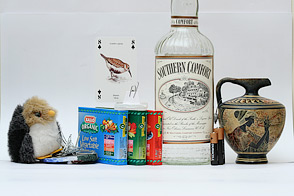




AdrianWarren.com: Reviews: Canon EOS 400D
Since the 400D has already been compared against its current competitors over at DPReview.com I thought it might be interesting to compare it against it's immediate predecessor, the EOS 350D (Digital Rebel XT). That way my review could bring something at least fractionally different to the table, and also hopefully be of use to those still shooting with the 350D but considering an upgrade. That said the EOS 450D (Digital Rebel XSi) has already been announced, although production cameras aren't shipping at the time of writing (1 March 2008).
For the purposes of a level playing field I chose to use the same lens for both cameras, a sharp prime, the Canon EF 100mm f/2.8 USM Macro. In (admittedly) non-rigorous testing, it outperformed my other lenses. The contenders were: Canon 17-40 f4/L, Canon 24-105 IS f4/L, Canon 200mm f2.8 L/II, and the Canon 300mm IS f4/L. Subsequent testing showed that the Macro performs best between f/9.5 and f/13 on the 400D, as it's diffraction limited beyond f/13.
I've attempted to recreate a scene along similar principles to the DPReview test scene, again using household objects rather than synthetic test charts to give an idea of how the camera may perform in the real world.
The Southern Comfort label provides plenty of B&W fine detail, so it gives an idea of the resolution of the camera, and also tests for moiré effects. The paperclips provide a specular (reflective) surface for highlight roll-off testing, and can sometimes show up demosaicing issues. The furry toy serves a dual purpose, it provides a shadow test and also a NR (noise reduction) test. If excessive NR is being applied then the fine texture of the fur will be destroyed, as NR is often applied heaviest in the shadow areas the darker fur areas are particularly of interest. Similarly the playing card of the Dunlin is there to give an indication of how well the camera handles low contrast scenes, and is another test that should show overzealous NR, this time in low contrast coloured areas. The stock cube boxes are there to provide some strong primary colours, as well as multi-coloured fine detail, which should test individual channel clipping and again NR.
The test scene may seem to have a disproportionately high number of NR tests, but as the pixel count of new models increases ever upwards, and the high ISO ratings continue to climb, it's one of the most important areas to test in a modern camera.
Lighting: Halogen (~2650K). Crops are 100%. Ambient temperature was approximately 22°C (~72°F).
Camera settings:
| Canon EOS 400D | Canon EOS 350D |
|
|
| 2857 kB (3888x2592) | 2535 kB (3456x2304) |
|
|
As you can see, the performance of the two cameras is very similar at a per-pixel level in JPEG. The 400D is resolving more, but that's in line with the increased pixel count; a total width increase of 432 pixels, and a height increase of just 288 pixels. Otherwise things are very even between the two, there's a slight difference in white balance between the two, but it's very minor. Ignoring the increase in resolution, colour and levels of detail are very similar which isn't surprising as they're both based on the same DIGIC II processor.
